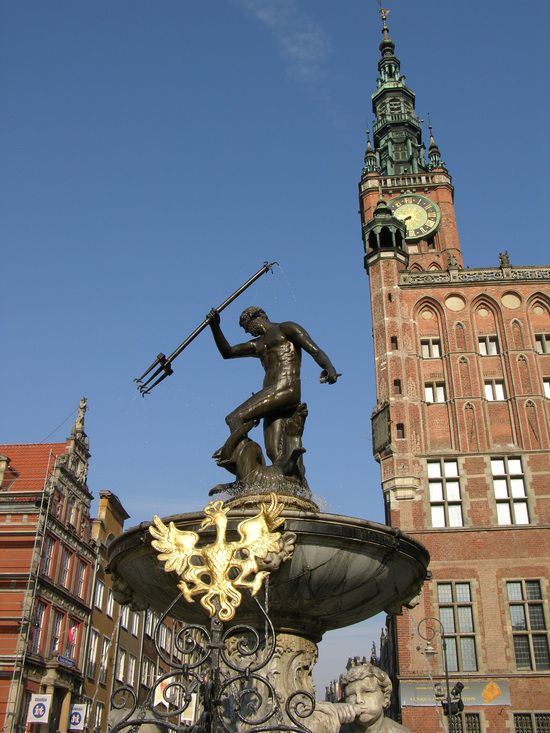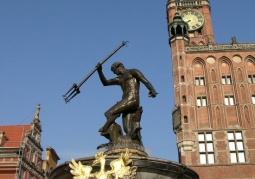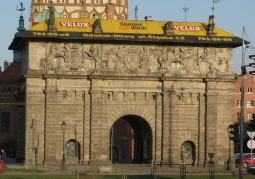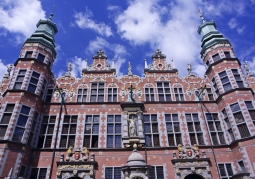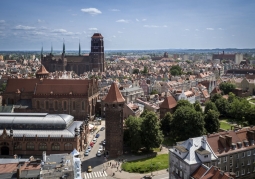Downtown - Gdansk
No weather data
0.0 /5
Number of ratings: 0
The district is located in the central-eastern part of the city on the Motława River on its both banks. It belongs to the historical district of Gdańsk. In the northeast, via the Dead Vistula, the district borders with the Port Island and more precisely the Przeróbka housing estate. From the south and east, the district is limited by the Motława River by which it borders with the administrative districts of Rudniki, Olszynka and Orunia-Św. Wojciech-Lipka. In the southwest through the elevation of Biskupia Górka, the district borders with Chełm, in the west with Siedlce and in the north with Angels and Młyniska. The area of the city in the inner circle of modern fortifications was 255 ha. The area of External Works, between internal and external fortifications, was 83 ha. The total area of the city inside embankments and bastions was 338 ha, and 589 ha with them. Before destruction in 1945, there were around 5,500 buildings in Śródmieście. On March 9, 1945, the bombing of Gdańsk by Soviet aircraft began, later also by American planes. On March 25, massive artillery fire of Śródmieście began. Further damage occurred during street fighting - Soviet soldiers set fire to the houses to force the Germans to flee. The arson also took place after the fighting ended. Downtown can be divided into: Old Town The oldest part of the city, located in the northern area of the district. The Radunia Canal flows through the Old Town creating a small island. The eastern part of the Old Town is formed by Osiek and Zamczysko (the area of the non-existent Teutonic castle). The original buildings have not survived to the present day, the majority are buildings built after World War II, existing monuments include, among others Old Town Hall, Great Mill, Church of St. Catherine and the building of the Polish Post Office in WMG, the place of Polish-German fighting on September 1, 1939. In the western end of the Old Town is the Gdańsk Główny train station. In the northern part of the area there is Solidarity Square with the Monument to the Fallen Shipyard Workers and the historic shipyard gate. The northern end of the Old Town and the entire district located behind the Błędnik viaduct is called the Oliwa Gate. Main City. A representative part of Gdańsk with a historic urban complex centered along the Royal Road (Długa Street, Długi Targ Street). It is located on the west bank of the Motława River, limited from the north by the Staromiejskie Lake, from the west by Okopowa and Wały Jagiellońskie streets, from the south by Podwale Przedmiejskie street. Numerous monuments include Main Town Hall, St. Mary's Basilica, Crane Gate, Neptune Fountain, Golden Gate. Nowe Ogrody Area along the street with the same name located west of the Main and Old Town. Administrative buildings dominate the buildings. Grodzisko. An area of preserved bastion fortifications from the 17th-19th centuries at the northwestern edge of the district between Nowe Gardens and the Old Town. Mount Gradowa towers over it with a viewpoint. In 2008, the Hevelianum Educational Center was established in this area. Old Przedmieście The southern end of the district is located on the west bank of the Motława river between Podwale Przedmiejskie and Okopowa streets, ending with fortifications along the Motława River. There is the Pomeranian Voivodeship Office, the National Museum in Gdańsk, historic buildings: the Holy Trinity Church, the Lowland Gate, the Żubr Bastion and the Kamienna Lock. Biskupia Górka. Hill 60.8 m a.s.l. at the southwestern edge of the district. The buildings are mainly pre-war tenement houses. At the top of the hill is the building of a youth hostel from 1939 with a clock tower, currently its buildings are used by the police. In addition, there are remains of bastion fortifications. Part of Biskupia Górka is located in the Chełm district. The area between Biskupia Górka and Old Suburb is called Zaroślak. Wyspa Spichrzów Wyspa na Motława located in the center of the district. Once an industrial district with numerous harbor granaries, buildings were almost completely destroyed in 1945 by the Red Army. The only preserved monument is Stągwie Dlecz. The northern part of the island has never been rebuilt. Ołowianka Island on the Motława River and the Canal on Stępka located north of Wyspa Spichrzów. Connected to the Long Gardens with the help of the Kamieniarski Bridge. Once an industrial district (municipal power plant), now it has a cultural function: the Baltic Philharmonic, the Central Maritime Museum in Gdańsk. At the waterfront of the island, the SS Sołdek museum ship is constantly mooring. The island is connected by a passenger ferry to the Long Coast. Long Gardens Area on the east bank of the Motława river around the street with the same name. It has a service and housing character. At Szafarnia street there is the Marina Gdańsk yacht marina. The monuments include: The Żuławska Gate, the Church of St. Barbara's or the preserved granary Nowa Pakownia. The Academy of Music is located here Stanisław Moniuszko. Lower Town Area in the south-eastern edge of the district, between the east bank of the Motława, the Motława River and the W-Z Route. It has a residential function, it extends along the axis of Łąkowa Street. The original frontage buildings from the 19th and 20th century have been preserved here, complemented with residential bullets from the PRL period. Sienna Grobla Area in the north-eastern part of the district, on the Dead Vistula. It has a residential and industrial character. Historically, you can distinguish here Sienna Dike I, Sienna Dike II, Knipawa and Rudno. The northern end of the district in the form of a promontory at the mouth of the Motława to the Martwa Wisła is called the Polish Hook. The Gdańsk Gdańsk speedway stadium is a characteristic building here.
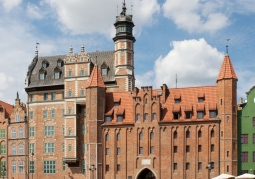
St. Mary's Gate
Category: GatesOne of the water gates of the Main Town of Gdańsk, located on the Motława River. It has late Gothic forms, probably built in the last quarter of the 15th century. In the basement there is a passage above which the...
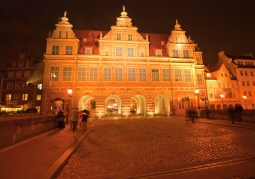
Green Gate
Category: GatesProbably the oldest of Gdansk's water gates. This is the first example of Dutch Mannerism in Gdańsk. It was built of small, Dutch bricks in the years 1564-1568 by Regnier from Amsterdam and Dresden Hans Kramer, as the...
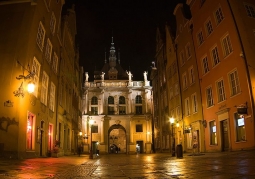
Golden Gate
Category: GatesBuilt in 1612 on the site of a 14th-century Gothic gate. It is the work of architect Abraham van den Blocke, Jan Strakowski also participated in the construction. Built in the style of Dutch Mannerism. It is a kind of...
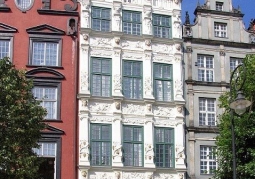
Golden Tenement House
Category: Tenement housesErected for the mayor Johann Speymann (a rich merchant and enlightened patron of art), who held the highest dignities and municipal offices in the early 17th century, and for his wife Judyta of Bachry. Today's mannerist...
Komentarze
No results
Nearby places
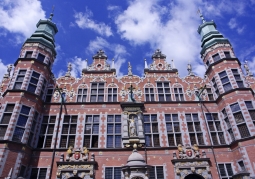
Great Armory - Downtown - Gdansk
Category: Tenement housesThe growing threat from Sweden at the end of the 16th century prompted Gdańsk townspeople to prepare for war. Feeling the lack of warehouses for the war equipment produced in the city and around, they decided to build...
1 km

Teatr Wybrzeże - Downtown - Gdansk
Category: TheatersTeatr Wybrzeże has at its disposal the Big Stage, the Malarnia Stage and the Black Hall in Gdańsk, as well as the Summer Stage in Pruszcz Gdański and the Chamber Stage in Sopot. Teatr Wybrzeże is also the organizer...
1 km

Jan III Sobieski Monument - Downtown - Gdansk
Category: MonumentsIt was unveiled on November 20, 1898 (founded by the city of Lviv). It is the work of Lviv sculptor Tadeusz Barącz, cast in bronze at Artur Krupp's Viennese workshop. The king was depicted in a traditional national...
1 km
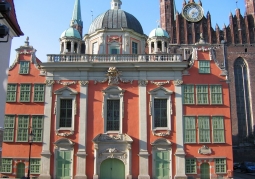
Royal Chapel - Downtown - Gdansk
Category: Churchesthe baroque Catholic chapel in the Main Town of Gdańsk was built in the years 1678 - 1681 on the initiative of Gdańsk Catholics with the help of King Jan III Sobieski. It was built as a temporary Catholic chapel for...
1 km
Nearby places

Great Armory - Downtown - Gdansk
Category: Tenement housesThe growing threat from Sweden at the end of the 16th century prompted Gdańsk townspeople to prepare for war. Feeling the lack of warehouses for the war equipment produced in the city and around, they decided to build...
1 km

Teatr Wybrzeże - Downtown - Gdansk
Category: TheatersTeatr Wybrzeże has at its disposal the Big Stage, the Malarnia Stage and the Black Hall in Gdańsk, as well as the Summer Stage in Pruszcz Gdański and the Chamber Stage in Sopot. Teatr Wybrzeże is also the organizer...
1 km

Jan III Sobieski Monument - Downtown - Gdansk
Category: MonumentsIt was unveiled on November 20, 1898 (founded by the city of Lviv). It is the work of Lviv sculptor Tadeusz Barącz, cast in bronze at Artur Krupp's Viennese workshop. The king was depicted in a traditional national...
1 km

Royal Chapel - Downtown - Gdansk
Category: Churchesthe baroque Catholic chapel in the Main Town of Gdańsk was built in the years 1678 - 1681 on the initiative of Gdańsk Catholics with the help of King Jan III Sobieski. It was built as a temporary Catholic chapel for...
1 km
